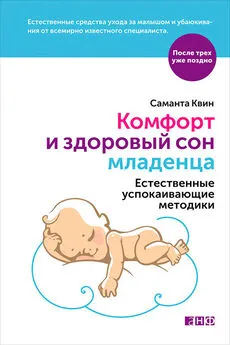Марк Вайсблут - Здоровый сон – счастливый ребенок
- Название:Здоровый сон – счастливый ребенок
- Автор:
- Жанр:
- Издательство:Array Литагент «Альпина»
- Год:2014
- Город:Москва
- ISBN:978-5-9614-3583-2
- Рейтинг:
- Избранное:Добавить в избранное
-
Отзывы:
-
Ваша оценка:
Марк Вайсблут - Здоровый сон – счастливый ребенок краткое содержание
Здоровый сон – счастливый ребенок - читать онлайн бесплатно ознакомительный отрывок
Интервал:
Закладка:
Weissbluth, M., Christoffel, K. K., and Davis, A. T. (1984). Treatment of infantile colic with dicyclomine hydrochloride. Journal of Pediatrics, 104, 951–955.
Weissbluth, M., Davis, A. T., and Poncher, J. (1984). Night waking in 4– to 8-month-old infants. Journal of Pediatrics, 104, 477–480.
Weissbluth, M., and Green, O. C. (1984). Plasma progesterone concentration and infant temperament. Journal of Developmental and Behavioral Pediatrics, 5, 251–253.
Weissbluth, M., Hunt, C., Brouillette, R. T., Hanson, D., David, R. J., and Stein, I. M. (1985). Respiratory patterns during sleep and temperament ratings in normal infants. Journal of Pediatrics, 106, 688–690.
Weissbluth, M., and Liu, K. (1983). Sleep patterns, attention span, and infant temperament. Journal of Developmental and Behavioral Pediatrics, 4, 34–36.
Weissbluth, M., and Weissbluth, L. (1992). Colic, sleep inertia, melatonin and circannual rhythms. Medical Hypotheses, 38, 224–228.
Wessel, M. A., Cobb, J. C., Jackson, E. B., Harris, G. S., and Detwiler, A. C. (1954). Paroxysmal fussing in infants, sometimes called ‘colic’. Pediatrics, 14, 421–434.
White, B. P., Gunnar, M. R., Larson, M. C., Donzella, B., and Barr, R. C. (2000). Behavioral and physiological responsivity, sleep, and patterns of daily cortisol production in infants with and without colic. Child Development, 71, 862–877.
Williams, C. D. (1959). The elimination of tantrum behaviour by extinction procedures. Journal of Abnormal and Social Psychology, 59, 269.
Wolke, D., Gray, P., and Meyer, R. (1994). Excessive infant crying: A controlled study of mothers helping mothers. Pediatrics, 94, 322–332.
Wolke, D., and Meyer, R. (1995). Co-morbidity of crying and feeding problems with sleeping problems in infancy: Concurrent and predictive associations. Early Development and Parenting, 4, 191–207.
Wolke, D, Rizzo, P., and Woods, S. (2002). Persistent infant crying and hyperactive problems in middle childhood. Pediatrics, 109, 1054–1060.
Zeskind, P. S., and Huntington, L. (1984). The effects of withingroup and between-group methodologies in the study of perceptions of infant crying. Child Development, 55, 1658–1665.
Глава 5. 1–4-й месяцы
Christophersen, E. (2002). Diagnosis and management of sleep problems. In Treatments That Work with Children. Washington, D. C.: American Psychological Association.
Etzel, B. C., and Gewirtz, J. L. (1967). Experimental modification of caretaker-maintained high-rate operant crying in a 6– and-20-week-old infant (Infans tyrannotearus): Extinction of crying with reinforcement of eye contact and smiling. Journal of Experimental Child Psychology, 5, 303–317.
Fagan, J. W., Ohr, P. J., Fleckenstein, L. K., and Ribner, D. R. (1985). The effects of crying on long-term memory in infancy. Child Development, 56, 1584–1592.
Leach, Penelope (1978). Your Baby and Child from Birth to Five. New York: Alfred A. Knopf.
Maziade, M., Boudreault, M., Cote, R., and Thivierage, J. (1986). Influence of gentle birth delivery procedures and other perinatal circumstances on infant temperament: Developmental and social implications. Journal of Pediatrics, 108, 134–136.
McGraw, K., Hoffman, R., Harker, C., and Herman, J. H. (1999). The development of circadian rhythms in a human infant. Sleep, 22, 303–310.
Spock, Benjamin. (1983). Baby and Child Care. New York: Pocket Books.
Глава 6. 5–12-й месяцы
Caren, S., and Searleman, A. (1985). Birth stress and self-reported sleep difficulty. Sleep, 8, 222–226.
Dinges, D. F., and Broughton, R. J. (1989). Sleep and Alertness: Chronobiological, Behavioral, and Medical Aspects of Napping. New York: Raven Press.
Douglas, J., and Richman, N. (1984). My Child Won’t Sleep. Hammondsworth, Middlesex, England: Penguin Books.
France, K. G., Blampied, N. M., and Wilkinson, P. (1991). Treatment of infant sleep disturbance by trimeprazine in combination with extinction. Journal of Developmental and Behavioral Pediatrics, 12, 308–314.
France, K. G. (1992). Behavior characteristics and security in sleep-disturbed infants treated with extinction. Journal of Pediatric Psychology, 17, 467–475.
Hirschberg, J. C. (1957). Parental anxieties accompanying sleep disturbance in young children. Bulletin of the Menninger Clinic, 21, 129–139.
Hiscock, H., and Wake, M. (2002). Randomised controlled trial of behavioural infant sleep intervention to improve infant sleep and maternal mood. British Medical Journal, 324, 1062–1072.
Hiscock, H., and Wake, M. (2001). Infant sleep problems and postnatal depression: A community based study. Pediatrics, 107, 1317–1322.
Klastskin, E. H., Jackson, E. B., and Wilkin, L. C. (1956). The influence of degree of flexibility in maternal care practices on early child behaviour. American Journal of Orthopsychiatry, 26, 79–93.
Lewis, M. (1997) Altering Fate: Why the Past Does Not Predict the Future. New York: The Guilford Press.
Mahler, M. S. (1972). On the first three subphases of the separation-individuation process. International Journal of Psycho-Analysis, 53, 333–338.
Peiyoong, L., Hiscock, H., Wake, M., and Epi, G. D. (2003). Outcomes of infant sleep problems: A longitudinal study of sleep, behaviour, and maternal well-being. Pediatrics. In press.
Richman, N., Douglas, J., and Hunt, H. (1985). Behavioral methods in the treatment of sleep disorders: A pilot study. Journal of Child Psychology and Psychiatry, 26, 581–590.
Thomas, A., and Chess, S. (1984). Genesis and evolution of behavioural disorders: From infancy to early adult life. American Journal of Psychiatry, 141, 1–9.
Webb, W. B., and Agnew, H. W. (1974). Regularity in the control of the free-running sleep-wakefulness rhythm. Aerospace Medicine, 45, 701–704.
Weissbluth, M. (1982). Modification of sleep schedule with reduction of night waking: A case report. Sleep, 5, 262–266.
Winnicott, D. W. (1965). The capacity to be alone. In D. W. Winnicott, The Maturational Processes and Facilitating Environment (29–36). New York: International Universities Press.
Глава 7. 13–36-й месяцы
Gutelius, M. E., and Kirsch, A. D. (1977). Controlled study of child health supervision: Behavioral results. Pediatrics, 60, 294–304.
Howarth, E., and Hoffman, M. S. (1984). A multidimensional approach to the relationship between mood and weather. British Journal of Psychology, 75, 5–23.
Kahyama, J., Shiike, T., and Hasegawa, T. (2000). Young children who are late sleepers sleep less than early sleepers. Sleep, 23 (Abstract Suppl. 2), A198 – A199.
Largo, R. H., and Honziker, U. A. (1984). A developmental approach to the management of children with sleep disturbances in the first three years of life. European Journal of Pediatrics, 142, 170–173.
Lozoff, B., Wolf, A. W., and Davis, N. S. (1985). Sleep problems seen in pediatric practice. Pediatrics, 75 , 477–483.
Lyons, J. T., and Oates, R. K. (1993). Falling out of bed: A relatively benign occurrence. Pediatrics, 92, 125–127.
Richman, N. (1981). A community survey of one– to two-year-olds with sleep disruptions. Journal of the American Academy of Child Psychiatry, 20, 281–291.
Scher, A., Tirosh, E., and Lavie, P. (1998). The relationship between sleep and temperament revisited: Evidence for 12-month-olds: A research note. Journal of Child Psychiatry and Allied Disciplines, 39, 785–788.
Van Tassel, E. B. (1985). The relative influence of child and environmental characteristics on sleep disturbances in the first and second years of life. Journal of Developmental and Behavioral Pediatrics, 6, 81–86.
Williams, C. D. (1959). Case report: The elimination of tantrum behaviour by extinction procedures. Journal of Abnormal and Social Psychology, 59, 269.
Глава 8. Дошкольники
Atkinson, E., Vetere, A., and Grayson, K. (1995). Sleep disruption in young children. The influence of temperament on the sleep patterns of pre-school children. Child: Care, Health and Development, 21, 233–246.
Bates, J. E., Viken, R. J., Alexander, D. B., Beyers, J., and Stockton, S. (2002). Sleep and adjustment in preschool children: Sleep diary reports by mothers relate to behaviour reports by teachers. Child Development, 73, 62–74.
Christophersen, Edward R. (1998). Beyond Discipline: Parenting That Lasts a Lifetime , 2nd ed. (127–128). Shawnee Mission, Kansas: Overland Press.
Clarkson, S., Williams, S., and Silva, P. A. (1986). Sleep in middle childhood – a longitudinal study of sleep problems in a large sample of Dunedin children aged 5–9 years. Australian Paediatric Journal, 22, 31–35.
Cullen, K. J. (1976). A 6-year controlled trial of prevention of children’s behaviour disorders. Journal of Pediatrics, 88, 662–666.
Fukuda, K., and Sakashita, Y. (2002). Sleeping pattern of kindergartners and nursery school children: Function of daytime nap. Perceptual and Motor Skills, 94, 219–228.
Gregory, A. M., and O’Connor, T. G. (2002). Sleep problems in childhood: A longitudinal study of developmental change and association with behavioural problems. Journal of the American Academy of Child & Adolescent Psychiatry, 41, 954–971.
Jones, D. P. H., and Verduyn, C. M. (1983). Behavioral management of sleep problems. Archives of Diseases of Children, 58, 442–444.
Kohyama, J., Shiike, T., Ohinata-Sugimoto, J., and Hasegawa, T. (2002). Potentially harmful sleep habits of 3-year-old children in Japan. Journal of Developmental and Behavioral Pediatrics, 23, 67–70.
Lavigne, J. V., Arend, R., Rosenbaum, D., Smith, A., Weissbluth, M., Binns, H. J., and Christoffel, K. K. (1999). Sleep and behaviour problems among preschoolers. Journal of Developmental and Behavioral Pediatrics, 20, 164–169.
Manber, R., Bootzin, R. R., Acebo, C., and Carskadon, M. A. (1996). The effects of regularising sleep-wake schedules on daytime sleepiness. Sleep, 19, 432–441.
Mantz, J., Muzet, A., Neiss, R. (1995). Sleep in 6-year-old children: Survey in school environment. Archives of Pediatrics, 21, 215–220.
Minde, K., Popiel, K., Leos, N., Falkner, S., Parker, K., and Handley-Derry, M. (1993). The evaluation and treatment of sleep disturbances in young children. Journal of Child Psychology and Psychiatry, 34, 521–533.
Owens-Stively, J., Frank, N., Smith, A., Hagino, O., Spirito, A., Arigan, M., and Alario, A. J. (1997). Child temperament, parenting discipline style, and daytime behaviour in childhood sleep disorders. Journal of Developmental and Behavioral Pediatrics, 18, 314–321.
Richman, N., Douglas, J., Hunt, H., Lansdown, R., and Levere, R. (1985). Behavioral methods in the treatment of sleep disorders – A pilot study. Journal of Child Psychology and Psychiatry, 26, 581–590.
Sekine, Y., Yamagami, T., Handa, K., Saito, T., Nanre, S., Kawaminami, K., Tokui, N., Yoshida, K., and Kagamimori, S. (2002). A dose-response relationship between short sleeping hours and childhood obesity: Results of the Toyama Birth Cohort Study. Child: Care, Health and Development, 28, 163–170.
Читать дальшеИнтервал:
Закладка:








![Андрей Курпатов - Счастливый ребенок. Универсальные правила [(дополненное)]](/books/1083759/andrej-kurpatov-schastlivyj-rebenok-universalnye.webp)

